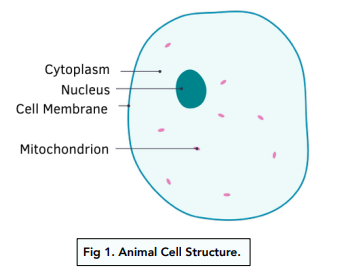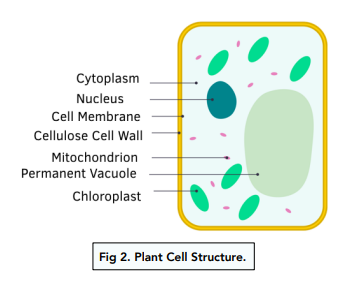Introduction to Cells - Animal and Plant Cells (GCSE Biology)
Animal and Plant Cells
Animal Cell Structure
Nucleus – genetic material is stored in the circular nucleus. Genetic material is vital to the life of an organism.
Cell membrane – The cell membrane controls the movement of substances in and out of the cell. These can contain receptor molecules to provide a selective barrier to molecules.
Mitochondria – the mitochondria is the powerhouse of the cell. It is the place where aerobic respiration occurs, producing energy needed for the cell to survive and function and contains enzymes for cellular respiration. The cells with high rates of metabolism contain a large number of mitochondria to provide enough energy.
Cytoplasm – the cytoplasm is a solvent in which chemical reactions take place. Enzymes are found in the cytoplasm.
Ribosomes – ribosomes are the site of protein synthesis in the cell.
Rough Endoplasmic Reticulum – this is where the ribosomes are located for protein synthesis.
Vesicles – these are fluid filled sacs that carry substances around the cell and in and out of the cell.

Plant Cell Structure
Plant cells have all of the above organelles, and in addition:
Cell Wall – the cell wall is made of cellulose, a carbohydrate. It is used to provide rigidity to the cell. Algal cells also have a cell wall.
Chloroplasts – these are the site of photosynthesis, which is required to make glucose for the plant. Chlorophyll in the chloroplasts absorbs light energy for photosynthesis, and gives leaves their green colour.
Vacuole – the vacuole contains sap which is a mix of salts and sugars.

Cells are the basic building blocks of all living things. They are tiny structures that contain all the necessary components to perform the functions required for life. There are two main types of cells in GCSE Biology: animal cells and plant cells.
Animal cells are one of the two main types of cells in GCSE Biology. They are typically smaller and simpler in structure compared to plant cells. Animal cells are characterized by the absence of a cell wall and the presence of a flexible membrane, called the cell membrane, that surrounds the cell.
Plant cells are one of the two main types of cells in GCSE Biology. They are typically larger and more complex in structure compared to animal cells. Plant cells are characterized by the presence of a rigid cell wall that surrounds the cell, in addition to a flexible cell membrane. The cell wall provides support and protection for the cell, and also helps regulate the exchange of materials between the cell and its environment.
There are several key differences between animal and plant cells in GCSE Biology, including the presence or absence of a cell wall, the size and complexity of the cells, and the types of organelles and structures found within the cells. Understanding the differences between animal and plant cells is essential for understanding how cells perform the functions required for life.
Cells perform a wide range of functions in GCSE Biology, including exchanging materials with their environment, producing energy, growing and dividing, and carrying out the processes required for life. Understanding the functions of cells is essential for understanding how living things maintain their structure and perform the processes required for life.
Cells exchange materials with their environment through the cell membrane, which acts as a selective barrier that regulates the exchange of materials between the cell and its environment. Materials can be exchanged through processes such as diffusion, osmosis, and active transport. Understanding the processes by which cells exchange materials with their environment is essential for understanding how cells maintain their structure and perform the functions required for life.
The organelles found within cells in GCSE Biology include the nucleus, which contains the genetic material of the cell, the mitochondria, which are the powerhouses of the cell and produce energy, and the endoplasmic reticulum and Golgi apparatus, which are involved in the production and processing of proteins. There are also other organelles, such as the lysosomes and peroxisomes, which are involved in breaking down waste materials and toxins. Understanding the organelles found within cells is essential for understanding how cells perform the functions required for life.
It is important to study cells in GCSE Biology because they are the basic building blocks of all living things, and they perform the functions required for life. Understanding the structure and functions of cells is essential for understanding how living things maintain their structure and perform the processes required for life. Additionally, understanding cells is essential for understanding a wide range of biological concepts and processes, including genetics, physiology, and evolution.






Still got a question? Leave a comment
Leave a comment